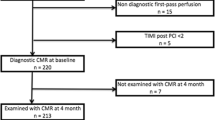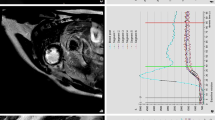Abstract
Objective
To evaluate the capabilities of delayed enhanced multidetector CT (DE-MDCT), performed immediately after percutaneous coronary intervention (PCI), in predicting myocardial microvascular obstruction (MVO) formation assessed by delayed enhanced MRI (DE-MRI).
Methods
Thirty-two patients presenting with a primary acute myocardial infarction, successfully recanalised by PCI, underwent a DE-MDCT immediately after PCI and a DE-MRI within 1 week. The left ventricle was split into 64 subsegments, rated as “healthy”, “infarcted” or “MVO” on DE-MRI. Their mean density was measured on DE-MDCT and calculated relative to the patient's mean healthy myocardium density. Hypoenhanced DE-MDCT subsegments, termed “CT early MVO”, were also recorded. Sensitivity and specificity of DE-MDCT for MRI-assessed “MVO” subsegments detection was calculated for mean CT relative density (threshold determined from a ROC analysis), “CT early MVO” and both.
Results
Mean CT relative density was higher in MRI-assessed “MVO” than in “infarcted” and “healthy” subsegments (1.82 ± 0.46, 1.43 ± 0.36 and 1.0 ± 0.13 respectively; P < 0.001) leading to a sensitivity and specificity of 94.3 % and 89.2 % for a cutoff of 1.36. Sensitivity and specificity were respectively 16.9 % and 99.8 % for “CT early MVO” and 95.3 % and 89.3 % when considering the two patterns.
Conclusion
DE-MDCT, performed immediately after PCI, allows for an accurate prediction of MVO formation.
Key Points
• Myocardial microvascular obstruction (MVO) is an important prognostic sequel following myocardial infarction.
• MVO can be accurately predicted by multidector CT (MDCT).
• Both hypo- and hyperenhanced myocardial areas can be analysed by MDCT.
• MDCT may become a useful prognostic tool for acute MI outcome.





Similar content being viewed by others
Abbreviations
- DE-MDCT:
-
Delayed enhanced multidetector CT
- MVO:
-
Myocardial microvascular obstruction
- PCI:
-
Percutaneous coronary intervention
- DE-MRI:
-
Delayed-enhanced magnetic resonance imaging
- CK:
-
Creatine kinase
- MPR:
-
Multiplanar reconstruction
References
Bolognese L, Carrabba N, Parodi G et al (2004) Impact of microvascular dysfunction on left ventricular remodeling and long-term clinical outcome after primary coronary angioplasty for acute myocardial infarction. Circulation 109:1121–1126
Brosh D, Assali AR, Mager A et al (2007) Effect of no-reflow during primary percutaneous coronary intervention for acute myocardial infarction on six-month mortality. Am J Cardiol 99:442–445
Cochet AA, Lorgis L, Lalande A et al (2009) Major prognostic impact of persistent microvascular obstruction as assessed by contrast-enhanced cardiac magnetic resonance in reperfused acute myocardial infarction. Eur Radiol 19:2117–2126
Ito H, Tomooka T, Sakai N et al (1992) Lack of myocardial perfusion immediately after successful thrombolysis. A predictor of poor recovery of left ventricular function in anterior myocardial infarction. Circulation 85:1699–1705
Wu KC, Zerhouni EA, Judd RM et al (1998) Prognostic significance of microvascular obstruction by magnetic resonance imaging in patients with acute myocardial infarction. Circulation 97:765–772
Ambrosio G, Weisman HF, Mannisi JA, Becker LC (1989) Progressive impairment of regional myocardial perfusion after initial restoration of postischemic blood flow. Circulation 80:1846–1861
Ito H, Maruyama A, Iwakura K et al (1996) Clinical implications of the 'no reflow' phenomenon. A predictor of complications and left ventricular remodeling in reperfused anterior wall myocardial infarction. Circulation 93:223–228
Kloner RA, Ganote CE, Jennings RB (1974) The "no-reflow" phenomenon after temporary coronary occlusion in the dog. J Clin Invest 54:1496–1508
Niccoli G, Burzotta F, Galiuto L, Crea F (2009) Myocardial no-reflow in humans. J Am Coll Cardiol 54:281–292
Reffelmann T, Kloner RA (2006) The no-reflow phenomenon: a basic mechanism of myocardial ischemia and reperfusion. Basic Res Cardiol 101:359–372
Verma S, Fedak PW, Weisel RD et al (2002) Fundamentals of reperfusion injury for the clinical cardiologist. Circulation 105:2332–2336
Albert TS, Kim RJ, Judd RM (2006) Assessment of no-reflow regions using cardiac MRI. Basic Res Cardiol 101:383–390
Habis M, Capderou A, Ghostine S et al (2007) Acute myocardial infarction early viability assessment by 64-slice computed tomography immediately after coronary angiography: comparison with low-dose dobutamine echocardiography. J Am Coll Cardiol 49:1178–1185
Boussel L, Ribagnac M, Bonnefoy E et al (2008) Assessment of acute myocardial infarction using MDCT after percutaneous coronary intervention: comparison with MRI. AJR Am J Roentgenol 191:441–447
Camilleri JP, Joseph D, Fabiani JN et al (1976) Microcirculatory changes following early reperfusion in experimental myocardial infarction. Virchows Arch A Pathol Anat Histol 369:315–333
Cobb FR, Bache RJ, Rivas F, Greenfield JC Jr (1976) Local effects of acute cellular injury on regional myocardial blood flow. J Clin Invest 57:1359–1368
Rochitte CE, Lima JA, Bluemke DA et al (1998) Magnitude and time course of microvascular obstruction and tissue injury after acute myocardial infarction. Circulation 98:1006–1014
Reffelmann T, Kloner RA (2002) Microvascular reperfusion injury: rapid expansion of anatomic no reflow during reperfusion in the rabbit. Am J Physiol Heart Circ Physiol 283:H1099–H1107
Chesebro JH, Knatterud G, Roberts R et al (1987) Thrombolysis in Myocardial Infarction (TIMI) trial, phase I: a comparison between intravenous tissue plasminogen activator and intravenous streptokinase. Clinical findings through hospital discharge. Circulation 76:142–154
Killip T 3rd, Kimball JT (1967) Treatment of myocardial infarction in a coronary care unit. A two year experience with 250 patients. Am J Cardiol 20:457–464
Puech PA, Boussel L, Belfkih S, Lemaitre L, Douek P, Beuscart R (2007) DicomWorks: software for reviewing DICOM studies and promoting low-cost teleradiology. J Digit Imaging 20:122–130
Cerqueira MD, Weissman NJ, Dilsizian V et al (2002) Standardized myocardial segmentation and nomenclature for tomographic imaging of the heart: a statement for healthcare professionals from the cardiac imaging committee of the council on clinical cardiology of the American heart association. Circulation 105:539–542
Jacquier A, Boussel L, Amabile N et al (2008) Multidetector computed tomography in reperfused acute myocardial infarction. Assessment of infarct size and no-reflow in comparison with cardiac magnetic resonance imaging. Invest Radiol 43:773–781
Lardo AC, Cordeiro MA, Silva C et al (2006) Contrast-enhanced multidetector computed tomography viability imaging after myocardial infarction: characterization of myocyte death, microvascular obstruction, and chronic scar. Circulation 113:394–404
Furtado AD, Carlsson M, Wintermark M, Ordovas K, Saeed M (2008) Identification of residual ischemia, infarction, and microvascular impairment in revascularized myocardial infarction using 64-slice MDCT. Contrast Media & Molecular Imaging 3:198–206
Manciet LH, Poole DC, McDonagh PF, Copeland JG, Mathieu-Costello O (1994) Microvascular compression during myocardial ischemia: mechanistic basis for no-reflow phenomenon. Am J Physiol 266:1541–1550
Basso C, Corbetti F, Silva C et al (2007) Morphologic validation of reperfused hemorrhagic myocardial infarction by cardiovascular magnetic resonance. Am J Cardiol 100:1322–1327
Beek AM, Nijveldt R, van Rossum AC (2010) Intramyocardial hemorrhage and microvascular obstruction after primary percutaneous coronary intervention. Int J Cardiovasc Imaging 26:49–55
Piot C, Croisille P, Staat P et al (2008) Effect of cyclosporine on reperfusion injury in acute myocardial infarction. N Engl J Med 359:473–481
Staat P, Rioufol G, Piot C et al (2005) Postconditioning the human heart. Circulation 112:2143–2148
Acknowledgements
We acknowledge Michel Ovize from the Department of Cardiology, Louis Pradel Hospital, Lyon, France, for his help with this manuscript.
Author information
Authors and Affiliations
Corresponding author
Rights and permissions
About this article
Cite this article
Amanieu, C., Sanchez, I., Arion, S. et al. Acute myocardial infarction: early CT aspects of myocardial microcirculation obstruction after percutaneous coronary intervention. Eur Radiol 23, 2405–2412 (2013). https://doi.org/10.1007/s00330-013-2853-7
Received:
Revised:
Accepted:
Published:
Issue Date:
DOI: https://doi.org/10.1007/s00330-013-2853-7




